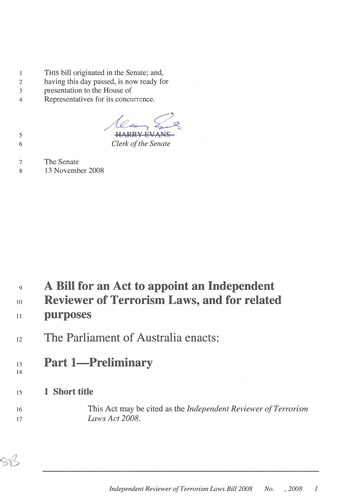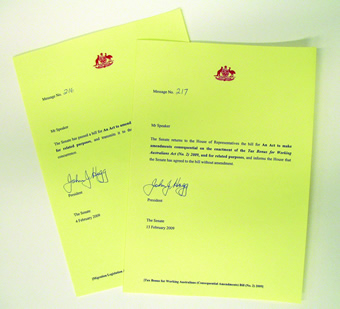125 Transmission to House of Representatives
-
When a bill originated in the Senate has been passed, the Clerk shall certify at the top of the first page: This bill originated in the Senate, and, having this day passed, is now ready for presentation to the House of Representatives for its concurrence.
-
After a bill has been so certified by the Clerk, it shall be sent with a message requesting the concurrence of the House of Representatives.
Amendment history
Adopted: 19 August 1903 as SOs 214 and 215 (corresponding to paragraphs (1) and (2)) but renumbered as SOs 213 and 214 for the first printed edition
1989 revision: Old SOs 220 and 221 combined into one, structured as two paragraphs and renumbered as SO 125; reference to Public and Private Bills in paragraph (1) deleted and language modernised
Commentary
Standing order 125 deals with the mechanics of processing a bill once it has been passed by the Senate. It applies to bills which have originated in the Senate.

The Clerk's certificate on a bill passed by the Senate

Bills passed by the Senate are transmitted to the House of Representatives under cover of a message signed by the President
Certification by the Clerk takes the following form, as prescribed by paragraph (1):
This bill originated in the Senate, and, having this day passed, is now ready for presentation to the House of Representatives for its concurrence.
Clerk of the Senate
The Senate
<date>
A message is prepared for the President’s signature in the following terms, as prescribed by paragraph (2):
Message No.
Mr Speaker
The Senate has passed a bill for <long title of the bill>, and transmits it to the House of Representatives for its concurrence.
President
The Senate
<date>
[<short title of the bill>]
When the Clerk has certified the bill and the President has signed the message, details of the message are entered in a register (kept at the Table) and the message is carried by the Usher of the Black Rod to the House of Representatives. If the House is not sitting, the message is delivered to the Clerk of the House (or, in practice, to the appropriate staff member in the Table Office).